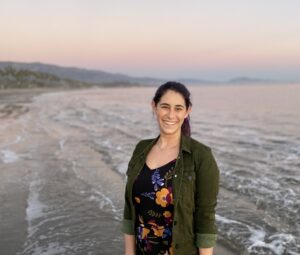Tova Handelman, Senior Marine Protected Areas Program Manager
Tova Handelman knows exactly the moment the ocean was destined to be her future. She was six years old, standing in front of the Monterey Bay Aquarium’s kelp exhibit. “It’s a stunning exhibit,” she recalled, “a fabulous slice of what a gorgeous kelp forest really looks like.” While beautiful to adults, to be a small child looking up at the kelp towering above her into the open air at the top of the exhibit was especially profound. “Wow, this is really what it looks like to live under the water in a kelp forest,” Tova remembered thinking. “This is the thing I want to do.” While she didn’t yet know what that could mean, the experience connected her to the ocean in a way that would eventually land her into where she is now a key leader in California’s Marine Protected Areas Management Program. 
But not right away. Initially she imagined herself working in an aquarium, immersing herself in conservation and science efforts. That was what was on her mind as she grew up in Los Angeles, playing water polo, swimming competitively and going to the beach every weekend. Tova scoped out what people she admired were doing, considered going to veterinary school, ultimately followed the path of “people who had cool jobs.” After graduating from UC Irvine in 2010, she scored an internship at the Heal the Bay Aquarium at the Santa Monica Pier. “It was very hard work,” she said. “You had to be smart, know how to work with chemicals – there was a lot more to it besides cleaning up fish poop!”
In addition to the mental and physical challenges, the internship offered Tova a chance to learn more about Heal the Bay’s ocean conservation policy work. When a job arose, Jose Bacallao, the senior aquarist and operations manager at the time, encouraged her to apply. She did – and got the job. Once in the main office, Tova was thrilled to be at the intersection of science and policy. “You’re not just making conservation policy for the sake of it,” she said, “but from a scientific perspective.” Science must inform policy in order for policy to be successful, she continued, especially in the natural resources realm. “The blend of science, policy and the human dimension most excited me, actually thinking about how we live on this planet and making sure we’re conserving the ocean in a way that is scientifically informed.”
This led her to her next chapter, moving across the country to work for Ocean Conservancy in Washington, D.C. as a marine debris science intern. Two years later, Tova returned to Heal the Bay’s aquarium where, among other achievements, she conceived and established the aquarium’s first Pacific Seahorse exhibit by implementing design elements necessary for seahorse survival. She then decided to return to school, following in the footsteps of others she admired by enrolling in the renowned Bren School of Environmental Science & Management at UC Santa Barbara. Another stint at Heal the Bay followed, this time as a coastal resource coordinator focused on marine protected areas, which led to her joining OPC’s MPA program as a California Sea Grant Fellow. Within two years, Tova leveled up to her current role as Senior Marine Protected Areas Program Manager.
This means working in partnership with multiple state and federal resource agencies, Tribal governments and ocean stakeholders to integrate science into MPA policy decisions, protecting the health of California’s ocean and coastal communities, and managing more than $32M of investments supporting ocean conservation and restoration, MPA-related outreach and education projects, statewide enforcement efforts, and innovative research into complex ocean problems including continued monitoring and data analysis. (Her dad prefers, reasonably, to abbreviate her portfolio, simply bragging to anyone who will listen that his daughter “is in charge of all the whales in California.”)
“I’m always amazed by this job,” Tova said. “I couldn’t think of a better fit for all things I wanted when I was six and standing in front of the kelp exhibit.” She’s proud of the relationships she’s built with people who depend on and love the ocean, from ocean professionals to those who recreate and enjoy it to those who rely on it for their livelihood. “When I look at the relationships I’ve built over the past decade, that’s what gives me hope. The ocean matters to so many people. Sometimes when you’re in the conservation space, you’re fighting a system that is not set up to conserve nature, but to take from it.” Seeing how many people understand that conservation is what will ensure future livelihoods provides optimism. “The ocean really is an inspiring place,” Tova said. “Something you can’t help but be in awe of.”
Particularly incredible – and something Tova wants more people to understand – is that “the ocean is actually so resilient that if we give it a chance to recover, science shows that it does.” In other words, if we are collectively making personal and policy choices allowing the ocean to heal, it will. “It’s only right we give it the opportunity,” Tova said.

